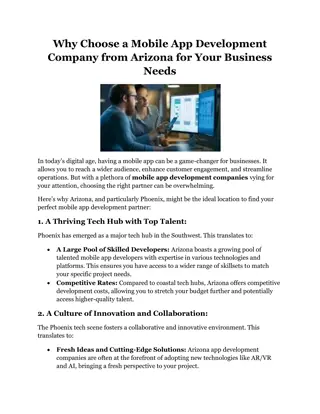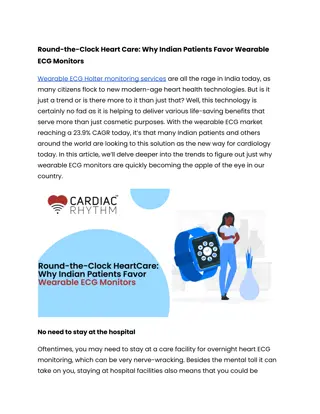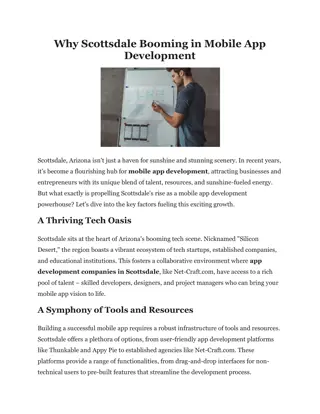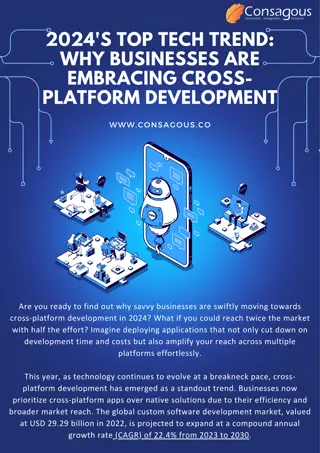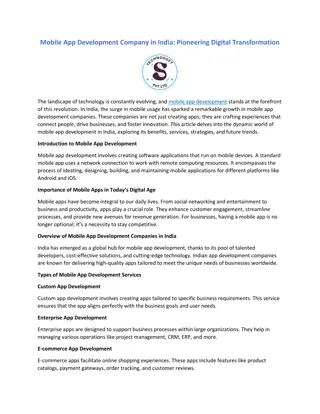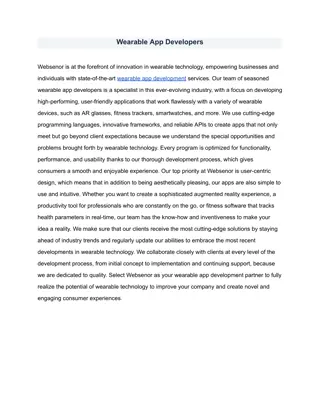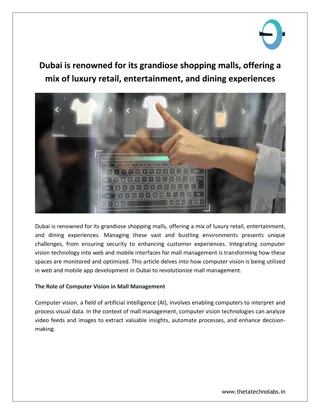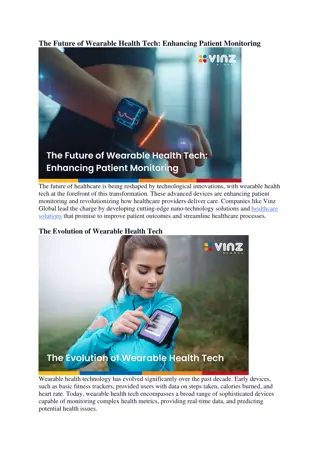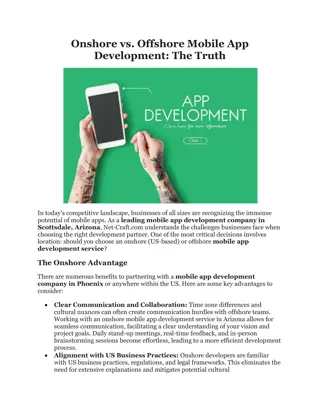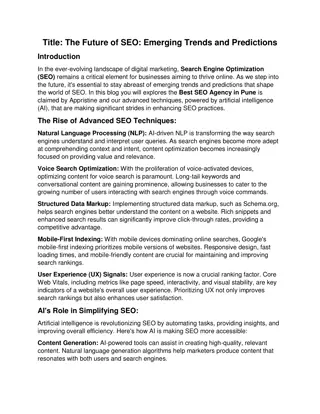
How Wearable Tech is Driving Innovation in Mobile App Development
Wearable technology is undoubtedly driving significant innovation in the mobile app development landscape. From improving user interfaces to enabling real-time health monitoring and integrating with the IoT, wearables are reshaping how apps are built
Download Presentation

Please find below an Image/Link to download the presentation.
The content on the website is provided AS IS for your information and personal use only. It may not be sold, licensed, or shared on other websites without obtaining consent from the author. Download presentation by click this link. If you encounter any issues during the download, it is possible that the publisher has removed the file from their server.
E N D
Presentation Transcript
How Wearable Tech is Driving Innovation in Mobile App Development ----------------------------------------------------------------------------------------------------------------- The landscape of mobile app development has been continuously evolving, with wearable technology now at the forefront of driving innovation. As consumers demand more integrated and seamless user experiences, wearables such as smartwatches, fitness trackers, and smart glasses are influencing how mobile apps are designed, developed, and deployed. This surge in wearable tech is reshaping the future of app development, particularly in the United States, where the demand for customized, high-performing apps is at an all-time high. In this blog, we will delve into the transformative impact of wearable technology on mobile app development, the innovative approaches being adopted by mobile app development companies in the USA, and some key statistics and tools that highlight the significance of this trend. The Rise of Wearable Technology Wearable technology has witnessed exponential growth in recent years. In 2023 alone, the global market size for wearable tech reached $63 billion, with projections to surpass $104 billion by 2027. This growth is driven by increasing consumer interest in health monitoring, fitness tracking, and smart home devices. Wearables such as the Apple Watch, Fitbit, and Google Glass have gained popularity and have become essential tools for users who want real-time data on their health, fitness, and lifestyle. The rise of wearable technology has revolutionized mobile app development, as developers must create apps that can seamlessly communicate with these devices. The demand for
apps that are intuitive, responsive, and able to handle vast amounts of real-time data is pushing companies to innovate continuously. How Wearables are Reshaping Mobile App Development 1. Enhanced User Experience and UI/UX Design Wearable technology has significantly impacted how mobile app development companies in the USA approach user interface (UI) and user experience (UX) design. Wearables typically have smaller screens and limited input methods compared to smartphones, meaning developers must prioritize minimalistic designs, clear navigation, and simplified user interactions. For instance, smartwatches display limited information, so developers must ensure that apps present only the most relevant data, making the experience efficient and user-friendly. App developers are adopting voice commands and gesture-based controls, allowing users to interact with wearables in non-traditional ways, enhancing both accessibility and functionality. 2. Integration with IoT (Internet of Things) Another area where wearable technology has impacted app development is its integration with the Internet of Things (IoT). Wearables are part of a larger ecosystem of connected devices that communicate with each other, such as smart home systems, healthcare devices, and fitness trackers. This has encouraged mobile development companies in the USA to create apps that can integrate with multiple devices simultaneously, offering a seamless and interconnected user experience. Wearable apps for IoT-powered homes can allow users to control everything from lighting to security systems directly from their wrist. This is becoming increasingly popular among users who want more control and flexibility, driving innovation in app development. 3. Data Security and Privacy Concerns With the rise of wearables comes the need for greater emphasis on data security and privacy. Wearable devices collect vast amounts of personal data, such as health metrics, location, and daily habits. To protect this sensitive information, app development services in the USA are adopting advanced encryption protocols, secure authentication methods, and compliance with regulatory frameworks like HIPAA for healthcare apps. Developers are focusing on enhancing security features to protect users' personal information while ensuring that apps can securely handle and transmit data across devices. This is especially critical for healthcare-related apps where a breach could have significant consequences.
Key Technologies and Tools for Wearable App Development 1. Bluetooth Low Energy (BLE) Bluetooth Low Energy (BLE) is one of the most widely used technologies in wearable devices. BLE enables low-power communication between wearables and mobile apps, ensuring that data can be exchanged without draining battery life. BLE plays a critical role in fitness trackers, smartwatches, and other wearables that need to transmit real-time data continuously. Many mobile app development companies in the USA are adopting BLE to enhance app performance and battery efficiency. 2. Cross-Platform Development Tools Wearable apps often need to work across multiple operating systems, such as iOS, Android, and even proprietary wearable OSs. To meet these demands, developers are using cross-platform development tools such as Flutter, React Native, and Xamarin. These tools allow for faster development cycles and ensure that apps can operate seamlessly on different devices, reducing time-to-market and enhancing user satisfaction. 3. AI and Machine Learning Artificial intelligence (AI) and machine learning (ML) are becoming indispensable tools for wearable app developers. By leveraging AI, apps can analyze data collected by wearables to provide personalized recommendations and insights. For example, fitness apps can suggest workout routines based on the user's previous performance, while healthcare apps can predict potential health issues based on trends in the user's data. Many app development companies in the USA are integrating AI-powered analytics into their wearable apps to offer a more customized and intelligent experience for users. Wearables in Specific Sectors: Healthcare and Fitness Wearables have made a particularly strong impact on healthcare and fitness apps, driving substantial innovation in these sectors. According to recent reports, 21% of Americans regularly use wearable devices to monitor their health. The healthcare industry, in particular, has seen the widespread adoption of wearables for remote patient monitoring, chronic disease management, and wellness tracking. 1. Healthcare Apps Wearable devices like smartwatches and fitness trackers are helping healthcare providers collect real-time data on patients, improving the accuracy of diagnoses and treatment plans. For example, apps connected to wearables can monitor a patient's heart rate, sleep patterns, and physical activity levels, providing insights that healthcare professionals can use to track patient progress. Healthcare app developers in the USA are leveraging this technology to create apps that integrate seamlessly with wearable devices, ensuring that patient data is accessible in real-time and shared securely with healthcare providers. 2. Fitness Apps Fitness apps have been at the forefront of wearable technology. Wearables like Fitbit and Garmin provide users with insights into their fitness routines, tracking metrics such as steps, calories burned, and sleep quality. These devices allow users to set
goals, track progress, and receive recommendations on improving their fitness levels. As a result, fitness app development companies are focusing on creating apps that integrate with wearables to deliver personalized fitness plans and real-time feedback, enhancing user motivation and engagement. The Future of Mobile App Development with Wearable Tech The future of mobile app development is intricately linked with the advancement of wearable technology. As wearables become more sophisticated, mobile app development in the US will need to adapt to these changing trends. Some future trends include: 5G Connectivity: The rollout of 5G will significantly boost the speed and efficiency of wearable devices, enabling faster data transfer and more complex functionalities for apps. Augmented Reality (AR): Smart glasses and AR-integrated wearables are set to revolutionize how we interact with both apps and the physical world. Developers will need to focus on building immersive and interactive experiences that leverage this technology. Improved Battery Life: As battery technology improves, wearable devices will become more powerful and last longer, allowing developers to build more feature-rich apps without the constraint of battery drain. Conclusion Wearable technology is undoubtedly driving significant innovation in the mobile app development landscape. From improving user interfaces to enabling real-time health monitoring and integrating with the IoT, wearables are reshaping how apps are built and function. As the demand for these devices grows, so does the need for cutting-edge app development solutions. Whether you're looking to build a healthcare app, fitness app, or an IoT-integrated solution, partnering with an experienced mobile development company in the USA can ensure that your app stays ahead of the curve. Contact Us At Consagous Technologies, we specialize in developing apps for wearable technology that deliver seamless performance and outstanding user experiences. If you're ready to innovate your mobile strategy, contact us today! Email: inquiry@consagous.co India: +91 75660 91454
USA: +1 (213) 257-8054 Explore our mobile app development services in the USA to see how we can help bring your wearable app vision to life. Top 5 FAQs on How Wearable Tech is Shaping Mobile App Development Q. How is wearable technology impacting mobile app development? Ans. Wearable technology is influencing mobile app development by driving a need for intuitive, minimalistic designs that fit smaller screens and provide seamless experiences. Developers must now create apps that integrate with devices such as smartwatches and fitness trackers while also considering new input methods like voice commands and gestures. Q. What technologies are commonly used for developing apps for wearables? Ans. Some of the key technologies used in wearable app development include Bluetooth Low Energy (BLE) for low-power communication, cross-platform development tools like Flutter and React Native for building apps across different operating systems, and AI and machine learning for providing personalized user experiences based on real-time data. Q. How do wearable apps ensure data security and privacy? Ans. Wearable devices collect vast amounts of sensitive data, such as health metrics and location. To ensure data security and privacy, app developers employ encryption protocols, secure authentication, and compliance with frameworks like HIPAA (for healthcare apps), protecting user data while enabling secure transmission across devices. Q. What industries benefit most from wearable app development? Ans. The healthcare and fitness industries are at the forefront of benefiting from wearable app development. Wearable devices allow for real-time health monitoring, fitness tracking, and remote patient care, enabling apps to provide personalised recommendations and insights, improving user engagement and health outcomes. Q. development? How is 5G connectivity expected to influence wearable app Ans. The rollout of 5G connectivity will significantly enhance the capabilities of wearable apps by enabling faster data transfer and more complex functionalities. With 5G, wearables
can provide real-time updates, seamless integration with IoT, and handle advanced features like augmented reality (AR), further revolutionising mobile app development. Original Source: https://bit.ly/3U1lcaE








